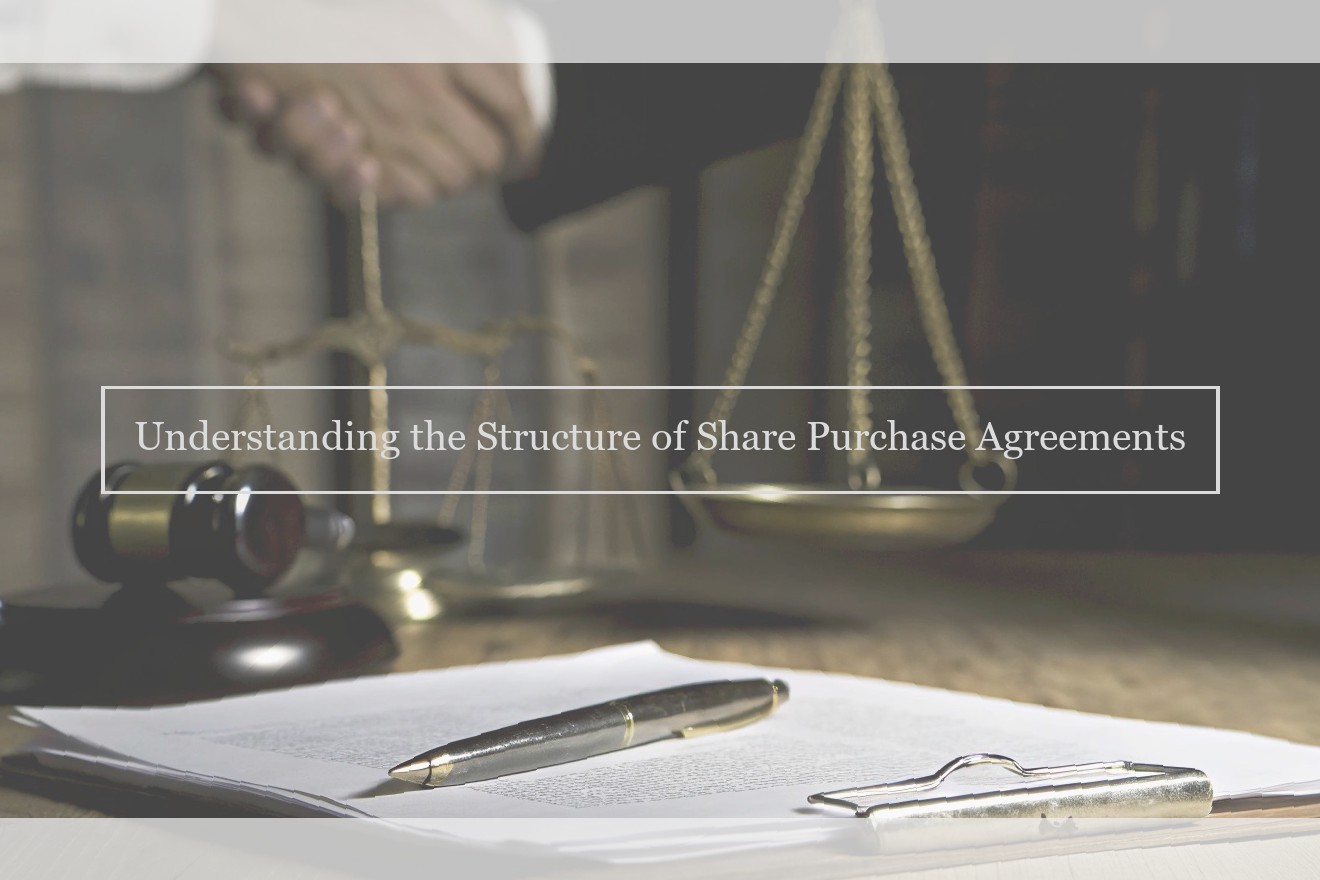Making Sense of Share Purchase Agreements
A Share Purchase Agreement (SPA) is a legally binding contract that documents the terms and conditions agreed upon between a buyer and a seller for the sale and purchase of a shareholding in a company. The main purpose of an SPA is to outline the rights and responsibilities of all parties involved in the transaction, in order to prevent potential disputes and misunderstandings during and after the deal has closed.
In the business world, SPAs are extremely important . When investing in a new company or merging with another entity, you want to ensure that you are protected against future liabilities and that you have legal recourse should something go wrong. Accordingly, the key terms we usually find in an SPA are: purchase price, completion accounts, pre-conditions to completion, termination rights, conditions that trigger indemnification rights, and liability caps and claim limitations. These items will change from deal to deal but the principle remains the same – both parties enter into a contract so that they understand exactly what they are getting into and what is expected of everyone.
Key Elements of a Share Purchase Agreement Format
Diving further into the world of share purchase agreements, we come across the characteristics common to most share purchase agreement formats. The parties to a share purchase agreement are the entity selling its stock or membership units and the entity or individual purchasing the stock or units. What is being sold is ownership of all or part of a company which has been incorporated as an entity.
One aspect of the share purchase agreement that the parties must agree on is the terms of the sale. Terms include: payment of the purchase price, delivery of certificates representing the shares, and due diligence by the purchaser to confirm that the seller is the owner of the shares. A seller of the shares must make sure all representations presented in the agreement are factual and true. If a seller does not, there may be legal grounds to pursue against that individual.
During the due diligence period the seller will represent and warrant to the buyer information about the company which the buyer should know before closing on the deal. The representations and warranties section of a share purchase agreement is among the most important in the agreement. In this section, the seller provides details about the business being sold, such as claims and lawsuits, the condition of physical assets, pending agreements and the financial condition of the business.
In addition to representations and warranties, the buyer of the company will request covenants from the seller after the sale. These covenants are legally binding promises by the seller to continue to operate the company in a specifically agreed-upon manner.
These covenants provide the names of those persons who are authorized to sign documents on behalf of the company, how the operations of the company will be organized, how the financial statements will be governed and how management decisions related to corporate actions are to be made.
Tailoring Your Share Purchase Agreement to Specific Transactions
A share purchase agreement can vary greatly from one transaction to another, and in the process of customizing the standard form for a particular situation, you will think about what is not standard: The industry in which the company operates, and the size of the company, in terms of employees and annual revenue. A smaller company with fewer products or services may be entirely dependent upon its principal customers for a large part of its revenue. In such a situation, the buyer may want to consider provisions in the purchase agreement to protect and inform them of any risks of loss of customers. A seller of a bottling plant, for example, might see a risk in losing customers at the time of transition due to unease over the transition. In contracts of this nature, the seller will want to provide a list of its customers with a history of payment. Collecting data on these issues will allow the buyer and seller to address them in the share purchase agreement and either mitigate them or prepare to deal with them when the time comes.
Primary Legal Considerations for Share Purchase Agreement Drafting
When drafting a share purchase agreement, it is essential to appreciate the legal nuances that should be taken into consideration, such as the laws to which each jurisdiction is subject, the due diligence process under applicable laws, and the compliance requirements with regulatory bodies within each jurisdiction. An important point to remember when drafting a share purchase agreement is who has the authority to sign the contract. In most countries, directors have the authority to sign the agreement on behalf of a company, unless restricted by the company’s charter or the relevant law (especially for companies listed on the stock exchange). Depending on the applicable laws, the authority to sign either may rest with the chairman of the board of directors, the board of directors, or any other designated officers of the company. In some cases, the authority must be obtained from the general assembly of the company, even for the chairman of the board of directors. In many cases, such requirements apply only to companies that are listed on the stock exchange or otherwise subject to certain laws and regulations; thus, it is advisable to seek legal advice in this regard. It is important for the seller and the buyer to ensure that the each party undergoes its regular due diligence process as required under applicable laws , regulations, and contracts, in order to protect both parties’ interests. In the case of a sale of shares in a private company, it is common for buyers to request and to conduct an examination from both legal and financial perspectives, of the target company’s assets and liabilities in order to ensure the value associated with the shares in question. Failure to do so could result in being held responsible for any undisclosed debts or defects and violations, whether intentional or otherwise. In the case of a transaction that impacts the trade industry between two countries, it is essential to check the regulatory requirements that apply to such cross-border transactions under the applicable laws and regulations. For example, if the buyer was selected based on qualifying criteria (such as the best price), the seller and the buyer should comply with such criteria while preparing the offer and signing the share purchase agreement. Compliance with certain regulatory bodies, including but not limited to the competition protection authority, is also mandatory. Unapproved mergers and acquisitions can lead to various penalties, including fines of up to 1 million SR for every day of delay, and if the violation is intentional, the offender can be imprisoned for a period not to exceed five years.
Pitfalls to Avoid When Choosing an Agreement Format
Form is something that we don’t really talk about much until the time we are served a notice by a adjudicating authority either to file additional information or to rectify the error. There are a few common mistakes, which include:
1. Using a boilerplate agreement. Using a template for the entire document instead of getting documents customized can backfire against you as the template may have been drafted in a completely different context or for a different purpose. It may also have been reviewed by a family lawyer and not an M&A lawyer. Using a standardized template may result in you finding a defect in the contract or legally inadequate terms, which may lead to the contract being void. A contract is void if it is not properly executed, and also if any of the parties was under a mistake as to a fundamental fact that goes to the root of the contract.
2. Improper execution of the agreement. The agreement must be properly executed in line with Section 57 of the Companies Act, 2013, which states that a company may execute a deed requiring or authorizing a signature on behalf of the company:
a) in the case of a company having a common seal, under its common seal;
b) in the case of a company not having a common seal, under the hand of the authorized director and the company secretary of the company, and if there is no company secretary under the hand of the director and the director.
3. Absence of penny stamp. It is mandatory to stamp every purchase agreement for shares, regardless of the value of the shares. As per Section 10 of the Indian Stamp Act, 1899, "Instruments chargeable for order for payment of money" all attentions have been paid to the stamping of the instrument, non-compliance with stamp duty requirements may result in a court refusing to act on that agreement. The remedy then is taking steps to get your instrument stamped without penalty or fine once the time limit as mentioned in the Stamp Act has elapsed.
Resources and Examples
There are a number of resources available for lawyers who are drafting a share purchase agreement for the first time. A good place to look is the Canadian Bar Association’s Electronic Library. This members-only resource includes precedent share purchase agreement files that can be downloaded and used as a starting point for your drafting. The precedents vary in scope and detail with some files providing more guidance on how to draft certain clauses than others. A number of the files contain helpful drafting notes that explain how to use and adapt the precedent provisions. These notes should be reviewed in detail when drafting a share purchase agreement.
The Canadian Bar Association Library also contains a number of sample letters and forms relating to share purchase agreements. If you need to draft a disclosure letter or a demand letter for escrowed shares or another letter or form relating to a share purchase transaction , then you should consider looking for an appropriate sample form in the library.
There are also a number of free share purchase agreement templates available online. While it can be tempting for a new lawyer to simply download one of these free templates and use it as is, using a generic template as a starting point for your drafting can lead to some significant risks. If the template you are using does not fit the deal you are working on then the resulting share purchase agreement may lack clarity in some key areas or may simply be incorrect. These deficiencies may not be discovered until after the closing of the deal and as a result may be very difficult to rectify at a later date.



+ There are no comments
Add yours